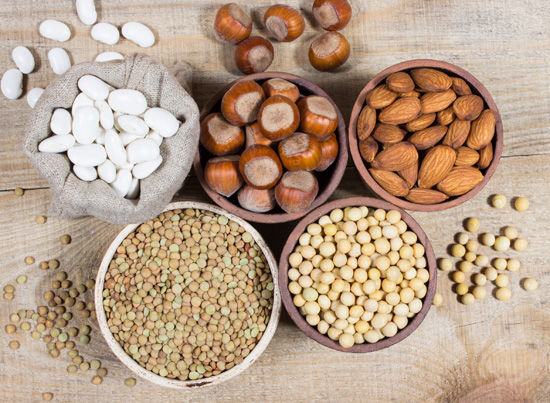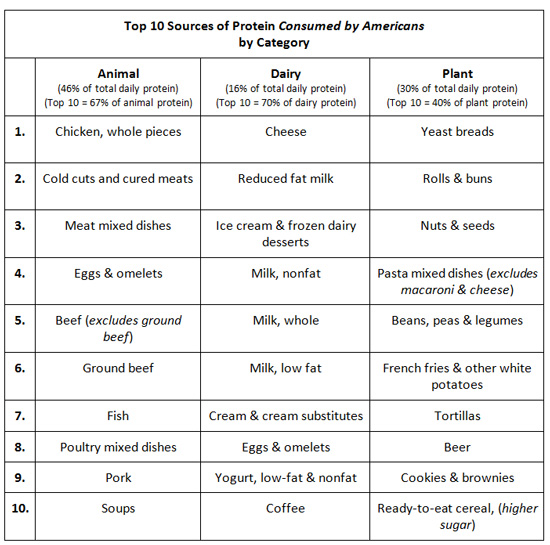About The Buzz: Americans Lacking Quality Sources of Plant-Based Protein?

WHAT THEY’RE SAYING
Americans’ main source of dietary protein comes from animal sources, followed by dairy and plant sources. However, the current top sources of plant proteins in the American diet aren’t top-notch and offer few health benefits.
WHAT THIS MEANS
Protein, the primary source of amino acids, particularly the essential amino acids, cannot be synthesized by the body and must be consumed through the diet. Amino acids are the building blocks of protein, a dietary nutrient required for human growth, development and maintenance of health. The recommended dietary allowance (RDA) for protein is 0.8 g per kilogram body weight (g/kg BW). Based on this recommendation, a healthy 150-pound male should consume 55 grams of protein each day. Individuals with certain physical goals, such as athletes striving for weight gain, weight loss, muscle gain, etc. require more dietary protein each day and should consult a nutritionist to help achieve their goals. Research is mixed about the benefits of consuming protein above the RDA. Some research shows that a high protein diet can be advantageous by promoting weight management and satiety, and providing minerals like iron, zinc, or vitamin B-6. A high protein diet, however, may be associated with too few plant foods in the diet, and plant foods like fruits and vegetables provide a variety of other vitamins, minerals and phytochemicals. The key is to eat the right types of protein sources.
WHAT THE RESEARCH SHOWS
Data from the present study was collected from 10,977 adults (19 years and older) who completed a 24-h dietary recall as a part of the National Health and Nutrition Examination Survey (NHANES), 2007–2010. The average protein intake was 82.3 grams/day, broken down to 98.6 g/day for men and 67.0 g/day for women. Animal protein intake accounted for 46% of overall daily protein intake; dairy 16% and plant protein 30%. (8% of protein intake could not be classified.)
The table below shows the top 10 foods in each protein category: animal, dairy and plant. The top 10 animal protein food categories provided approximately 67% of total animal protein intake but less than 16% of total energy intake. The top 10 dairy protein food categories provided nearly 70% of total dairy protein intake and 11% of total energy intake. The top 10 plant protein food categories provided approximately 40% of total plant protein intake and 20% of total energy intake. See below for the top sources of protein Americans eat.
WHAT THIS MEANS
As you can see from the table above, Americans habitually consume protein that is predominantly animal-based. In addition, the top sources of plant protein in the American diet are not nutritionally dense foods. In fact, many items in the top 10 sources of plant protein are processed foods that lack much nutrition. Americans would benefit greatly by shifting their diet from some of the current plant-based sources of protein to more nutritious plant-based protein-rich foods, like beans, nuts, and vegetables. The best sources of plant proteins have numerous other desirable attributes, such as fiber, probiotics, antioxidants and plenty of vitamins and minerals, such as iron, magnesium, potassium and B-vitamins.
OUR ADVICE
With so many delicious and nutritious ways to add high quality plant protein to your diet, there is no room for brownies, cookies and beer to make your personal top 10 list for plant protein! There is no harm in enjoying these sweets and treats every once in awhile, because leading a healthy, active life is all about achieving balance. Regardless of the protein source you choose (plant vs. animal vs. dairy), be sure to fill half your plate with fruits and veggies during each meal and snack. For better sources of protein-packed, plant-based foods, check out the list below.2
Video Center: Selection. Storage. Preparation.
How Many Cups Do You Need?
Key Nutrients in Fruits & Vegetables
Fruit & Veggie Database




